The D1 Football Workout Program PDF is a comprehensive guide tailored for Division 1 athletes, offering key components, sample routines, and expert tips to optimize performance and reach full athletic potential․
Overview of the Program
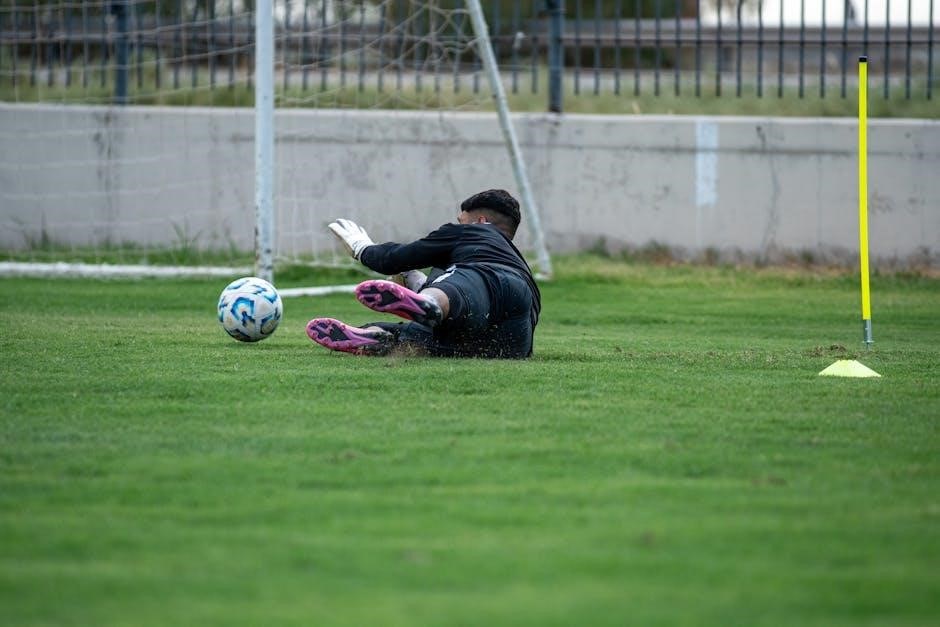
The D1 Football Workout Program PDF is a detailed guide designed to prepare athletes for the rigorous demands of Division 1 football․ It combines strength training, power production, plyometrics, and conditioning to enhance performance․ The program emphasizes a structured approach, catering to individual player needs while focusing on muscle building, speed, and agility․ Advanced techniques, such as high-intensity interval training (HIIT), are included to mimic game scenarios․ Recovery and nutrition are also highlighted to ensure sustainability and optimal results․ The program requires at least 1-2 years of lifting experience and offers customizable routines for off-season, in-season, and position-specific training․ This comprehensive resource is tailored to help athletes achieve their full potential and dominate on the field․
Importance of a Structured Workout Plan
A structured workout plan is crucial for achieving peak performance in D1 football․ It ensures consistency, progression, and avoids plateaus by targeting specific goals like strength, power, and explosiveness․ A well-designed plan helps athletes build muscle, improve speed, and enhance agility while addressing recovery and nutrition․ This approach minimizes injuries and maximizes efficiency, allowing players to perform at their best during games․ By following a structured program, athletes can develop the physical and mental resilience needed for the demands of Division 1 football, ensuring they are prepared for both the off-season and in-season challenges․ A structured plan is the foundation for unlocking full potential and achieving success on the field․
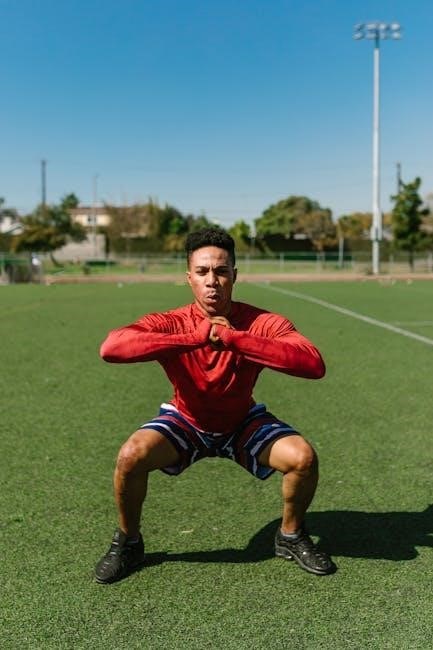
Understanding the Demands of D1 Football
D1 football requires elite speed, strength, agility, and endurance․ Players must excel in power, precision, and mental resilience․ The sport demands high-intensity performance over prolonged periods, combining tactical awareness, teamwork, and physical prowess․ Athletes need to adapt to varying game scenarios, showcasing explosive acceleration and sustained energy․ Success at this level hinges on a blend of physical conditioning, strategic thinking, and mental fortitude, making it one of the most challenging and rewarding sports․
Physical Requirements for Division 1 Football Players
D1 football players must possess exceptional strength, speed, agility, and endurance․ They need explosive power for sprinting and tackling, combined with muscular endurance to sustain high-intensity efforts․ Quick acceleration and deceleration are critical for changing direction rapidly․ Players must also maintain a high power-to-weight ratio, enabling them to dominate physically while remaining agile․ Flexibility and mobility are essential to prevent injuries and perform complex movements․ The demands vary by position, with linemen requiring brute strength and receivers needing elite speed․ Overall, D1 athletes must be well-rounded physically, blending raw power with finesse and stamina to excel at the highest level of competition․
Mental and Tactical Preparation
Mental and tactical preparation is critical for D1 football players to outperform opponents․ It involves developing focus, discipline, and strategic thinking․ Players must master game strategies, read opponents, and make split-second decisions․ Film study and situational awareness are key to anticipating plays and executing assignments․ Mental resilience is built through visualization, positive mindset, and stress management․ Tactical preparation includes understanding formations, coverage schemes, and blocking techniques․ Players must also communicate effectively and adapt to in-game adjustments․ Combining mental sharpness with physical skill ensures peak performance․ This preparation enables athletes to stay composed under pressure and make impactful plays consistently․ It’s the backbone of success in high-level competition․
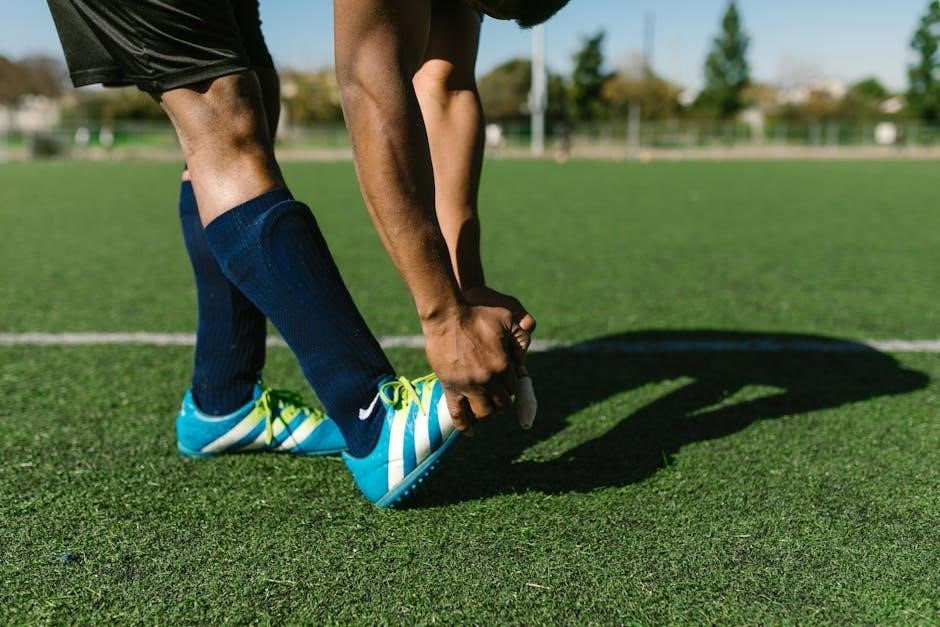
Key Components of the Workout Program
The D1 football workout program focuses on strength, power, plyometrics, agility, conditioning, recovery, and nutrition to optimize performance and durability;
Strength Training
Strength training is a cornerstone of the D1 football workout program, focusing on building muscular power and endurance․ It emphasizes compound lifts such as squats, deadlifts, and bench presses to target multiple muscle groups simultaneously․ These exercises improve overall athleticism and prepare players for the physical demands of the sport․ The program incorporates progressive overload, gradually increasing weights or reps to ensure continuous gains․ accessory exercises like pull-ups and lunges are also included to address imbalances and enhance functional strength․ Proper form and technique are prioritized to minimize injury risk while maximizing results․ This structured approach ensures players develop the raw strength needed for explosive movements and sustained performance on the field․
Power Production and Explosiveness
Power production and explosiveness are critical for D1 football players to excel in high-intensity actions like sprinting, jumping, and rapidly changing direction․ Exercises such as box jumps, depth jumps, and burpees are integral, focusing on plyometric movements that enhance muscle power and reactivity․ Olympic lifts like the clean and jerk and snatch are also essential, promoting explosive strength through dynamic movements․ Proper technique is emphasized to prevent injuries and maximize efficiency․ Periodization is key, balancing intensity and recovery to avoid overtraining․ Complementary drills in speed and agility further enhance explosiveness, while flexibility and mobility exercises improve range of motion for effective power movements․ Core strength is also vital, providing the stability needed for explosive actions․ This comprehensive approach ensures athletes can perform at peak levels during games․
Plyometrics and Agility
Plyometrics and agility training are vital for D1 football players to enhance quickness, acceleration, and directional changes․ Plyometric exercises, such as lateral bounds and box jumps, improve explosive power and reaction time․ Agility drills, including ladder workouts and cone drills, focus on sharp cuts, rapid foot movements, and balance․ These exercises mimic game scenarios, helping players navigate the field with precision․ Incorporating resistance bands and reaction training further boosts agility and responsiveness․ Proper form and technique are emphasized to prevent injuries and maximize performance․ By combining plyometrics and agility, athletes develop the speed and nimbleness needed to outperform opponents on the field․
Conditioning and Endurance
Conditioning and endurance are critical for D1 football players to maintain high-energy performance throughout the game․ The program incorporates aerobic and anaerobic exercises to build stamina and increase lactate threshold․ Interval sprints, pro agility shuttle runs, and endurance drills simulate game scenarios, enhancing speed and recovery between plays․ Hill sprints and long-distance runs improve cardiovascular fitness, while battle ropes and circuit training boost muscular endurance․ Proper pacing and progressive overload ensure players can sustain effort over four quarters․ Conditioning also focuses on reducing fatigue and improving mental toughness, enabling athletes to perform at peak levels even in the final minutes of a game․ This ensures they can outlast opponents and execute plays effectively․
Recovery and Injury Prevention
Recovery and injury prevention are essential for maintaining player health and performance․ The program emphasizes foam rolling, stretching, and dynamic warm-ups to improve flexibility and reduce muscle tension․ Structured cool-down routines post-workout aid in muscle recovery and prevent soreness․ Adequate sleep (7-9 hours) is stressed to allow the body to heal and adapt․ Nutrition plays a role, with guidelines for optimal recovery-focused eating․ Techniques like compression garments, ice baths, and massage are incorporated to minimize muscle fatigue․ Additionally, injury prevention exercises target weaker areas, and physical therapy is integrated to address existing issues․ Proper hydration is also highlighted to support overall recovery and muscle function․ Prioritizing recovery ensures athletes can train at maximum intensity while reducing the risk of injury, ultimately enhancing performance and longevity in the sport․
Nutrition and Supplementation
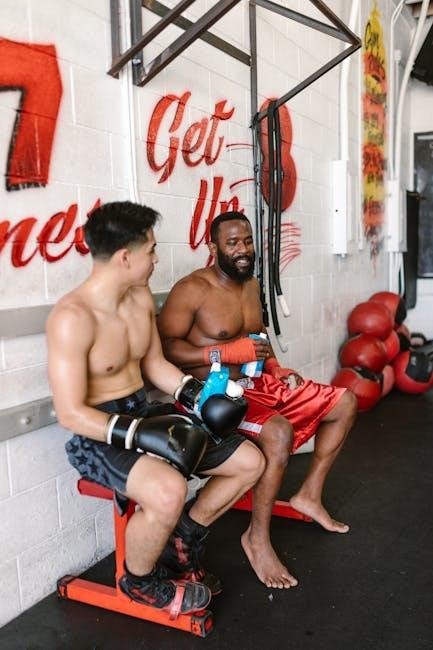
Nutrition and supplementation are critical for fueling performance and supporting recovery․ A balanced diet rich in lean proteins, complex carbohydrates, and healthy fats is essential to meet energy demands and build muscle․ Protein intake is emphasized for muscle repair and growth, with recommendations tailored to individual needs․ Carbohydrates provide sustained energy, while fats support hormonal health․ Hydration is prioritized to maintain performance and prevent fatigue․ Supplements like protein powder, creatine, and multivitamins are suggested to fill nutritional gaps and enhance recovery․ The program provides meal planning strategies and timing guidelines to optimize intake․ Personalized nutrition plans are encouraged to address specific needs and preferences, ensuring athletes are fueled for peak performance․

Sample Workout Routines
The program offers detailed workout plans, including off-season strength building, in-season maintenance, and position-specific drills to enhance performance and adapt to player roles effectively․
Off-Season Training
Off-season training in the D1 football workout program focuses on building strength, power, and endurance․ It typically includes 4-6 days of structured workouts per week, with an emphasis on weightlifting, plyometrics, and conditioning drills․ Players engage in exercises like squats, deadlifts, bench presses, and power cleans to enhance max strength and explosiveness․ Conditioning drills such as sprints, hill climbs, and pro agility shuttle runs improve speed and agility․ The program also incorporates position-specific skills, ensuring players maintain and refine their technique during the off-season․Nutrition and recovery strategies are emphasized to support muscle growth and prevent overtraining․ This phase is critical for preparing athletes to meet the intense demands of the upcoming season․
In-Season Maintenance
In-season maintenance ensures D1 football players sustain their physical and mental edge during competition․ Workouts are tailored to maintain strength, endurance, and explosiveness without overtraining․ Teams often reduce the intensity and volume of off-season workouts, focusing on active recovery and skill refinement․ Strength circuits, dynamic stretching, and low-intensity conditioning drills are common․ Practices emphasize game-specific drills and tactical preparation․ Recovery strategies, such as ice baths and compression therapy, are prioritized to prevent fatigue․ Proper nutrition and hydration are stressed to fuel performance and aid recovery․ This phase balances maintaining fitness levels with avoiding burnout, ensuring players remain competitive throughout the season․
Position-Specific Drills
Position-specific drills tailor workouts to the unique demands of each role on the field․ Quarterbacks focus on accuracy, footwork, and pocket presence, while wide receivers prioritize route running and catching techniques․ Linemen engage in blocking and agility drills, emphasizing hand placement and explosiveness․ Linebackers work on tackling, coverage, and reaction drills, while defensive backs focus on press coverage and ball skills․ Special teams players practice kicking, punting, and return drills․ These drills enhance position-specific skills, ensuring players excel in their roles․ Coaches design exercises to mimic game scenarios, improving decision-making and execution․ This targeted approach maximizes performance and prepares athletes for the competitive demands of D1 football․

Progression and Periodization
Progression and periodization involve systematically increasing workout intensity and structuring training phases to optimize performance and recovery․ This scientific approach ensures athletes meet individual and team goals without overtraining․
Adjusting Workouts Based on Player Needs
Workouts must be tailored to address individual player needs, ensuring each athlete progresses effectively․ Coaches assess player fitness levels, strengths, and weaknesses to create personalized plans․ This customization helps target specific areas, such as improving speed for a lineman or enhancing endurance for a wide receiver․ Regular monitoring allows adjustments to be made, keeping athletes on track to meet their goals․ Flexibility in programming prevents plateaus and minimizes the risk of overtraining․ By prioritizing individualization, coaches ensure that every player contributes optimally to the team’s success․ This adaptive approach fosters continuous improvement and aligns with the broader objectives of the D1 football workout program․
Ensuring Continuous Improvement
Continuous improvement is vital for athletes to stay competitive at the D1 level․ Coaches implement progressive overload, gradually increasing intensity and volume to challenge players․ Regular assessments, such as strength tests and speed drills, track progress and identify areas for growth․ Players are encouraged to set specific, measurable goals, fostering accountability and motivation․ Incorporating varied training stimuli, like dynamic exercises and functional movements, prevents plateaus․ Open communication between athletes and coaches ensures adjustments are made to optimize results․ Emphasizing proper technique and form minimizes injury risks while enhancing performance gains․ This structured, evolving approach guarantees athletes consistently advance toward their peak potential, aligning with the program’s high standards․

Tips for Success
Adhere to the program consistently, prioritize recovery, and maintain a healthy diet․ Stay disciplined, set achievable goals, and track progress regularly․ Surround yourself with supportive mentors and teammates to stay motivated․ Adapt to challenges, embrace feedback, and remain committed to long-term development․ Mental toughness and resilience are key to overcoming obstacles and achieving peak performance․
Consistency and Discipline
Consistency and discipline are cornerstone principles of the D1 Football Workout Program․ Players must commit to regular, high-intensity training sessions without deviation․ Skipping workouts or neglecting proper form can hinder progress and increase injury risk․ Discipline extends beyond the field; it includes adhering to nutrition plans, recovery protocols, and sleep schedules․ Consistency builds habits that translate to peak performance during games․ By staying focused and dedicated, athletes develop the mental and physical resilience needed to compete at the highest level․ Over time, discipline becomes second nature, ensuring sustained growth and success in the program․ Relentless effort and unwavering commitment are non-negotiable for achieving D1 football excellence․
Monitoring Progress and Adjustments
Monitoring progress and making adjustments are critical components of the D1 Football Workout Program․ Coaches and athletes track metrics such as strength, speed, and agility to assess improvement․ Regular assessments ensure workouts remain challenging and aligned with goals․ Data from training sessions, film analysis, and performance tests guide adjustments; As players develop, the program evolves to address new needs or overcome plateaus․ Adjustments might include modifying weights, reps, or focusing on specific skills․ Open communication between athletes and coaches ensures personalized tweaks for optimal results․ Continuous monitoring and adaptive changes maximize progress, keeping players on track to achieve peak performance․ This iterative process is vital for long-term success in the program․
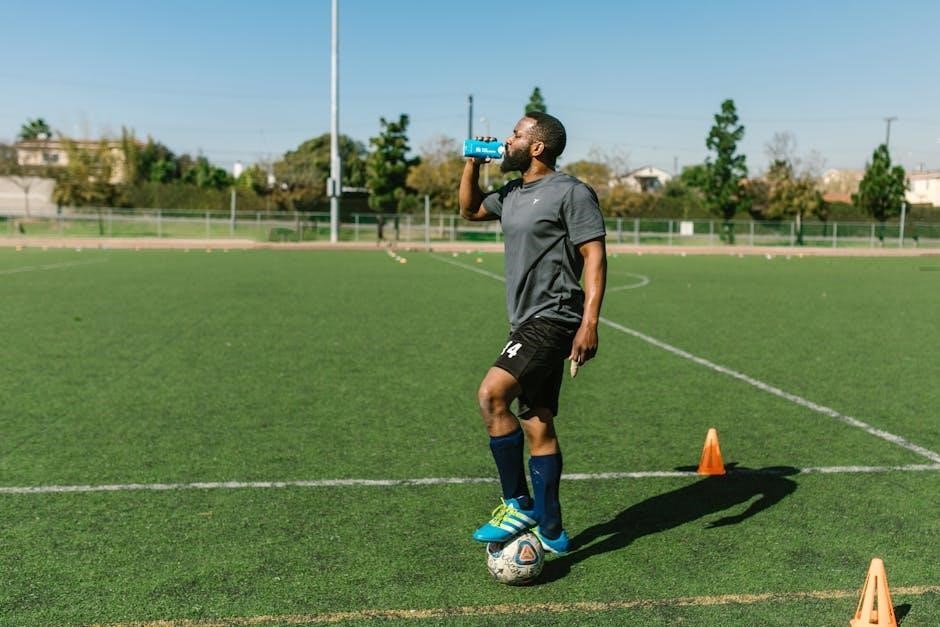
Mental Preparation and Toughness
Mental preparation is essential for D1 football, enhancing resilience, focus, and confidence․ Techniques like visualization, mindfulness, and positive self-talk help players overcome pressure and adversity, fostering a winning mindset․
Building Mental Resilience
Mental resilience is crucial for D1 football players to handle the physical and emotional demands of the sport․ It involves developing a growth mindset, embracing challenges, and bouncing back from setbacks․ Techniques like mindfulness, visualization, and positive self-talk help players stay focused under pressure․ Coaches often incorporate mental toughness exercises into training, such as goal setting and stress management, to prepare athletes for high-stakes environments․ Building resilience enables players to maintain confidence, overcome injuries, and perform consistently at elite levels․ A strong mental foundation complements physical training, ensuring athletes can thrive in the competitive world of Division 1 football․
Visualization and Focus Techniques
Visualization and focus techniques are essential for D1 football players to enhance performance and maintain concentration․ Visualization involves mentally rehearsing plays, scenarios, and skills to build muscle memory and confidence․ Players imagine themselves executing perfect techniques, overcoming challenges, and achieving success․ Focus techniques, such as mindfulness and concentration exercises, help athletes stay present and avoid distractions during games․ Coaches often incorporate these practices into training, teaching players to narrow their attention on key cues and maintain composure under pressure․ By combining visualization with focused mental strategies, athletes can improve decision-making, react faster, and perform at their best in high-stakes situations․ These methods complement physical training, ensuring peak mental and physical alignment․

The D1 Football Workout Program PDF offers a comprehensive approach to meeting the physical and mental demands of elite football․ Strategic training, consistency, and dedication are key to unlocking peak performance and achieving success at the highest level․
Final Thoughts on the D1 Football Workout Program
The D1 Football Workout Program PDF is a meticulously designed guide tailored for athletes striving to excel at the highest collegiate level․ By integrating strength training, power production, agility, and conditioning, it ensures a well-rounded development of physical and mental capabilities․ The program emphasizes the importance of recovery, nutrition, and tactical preparation, creating a holistic approach to football excellence․ Athletes who commit to this structured plan can expect significant improvements in performance and resilience․ Consistency and dedication are paramount, as the program is crafted to push athletes to their limits and beyond, preparing them for the intense demands of Division 1 football․